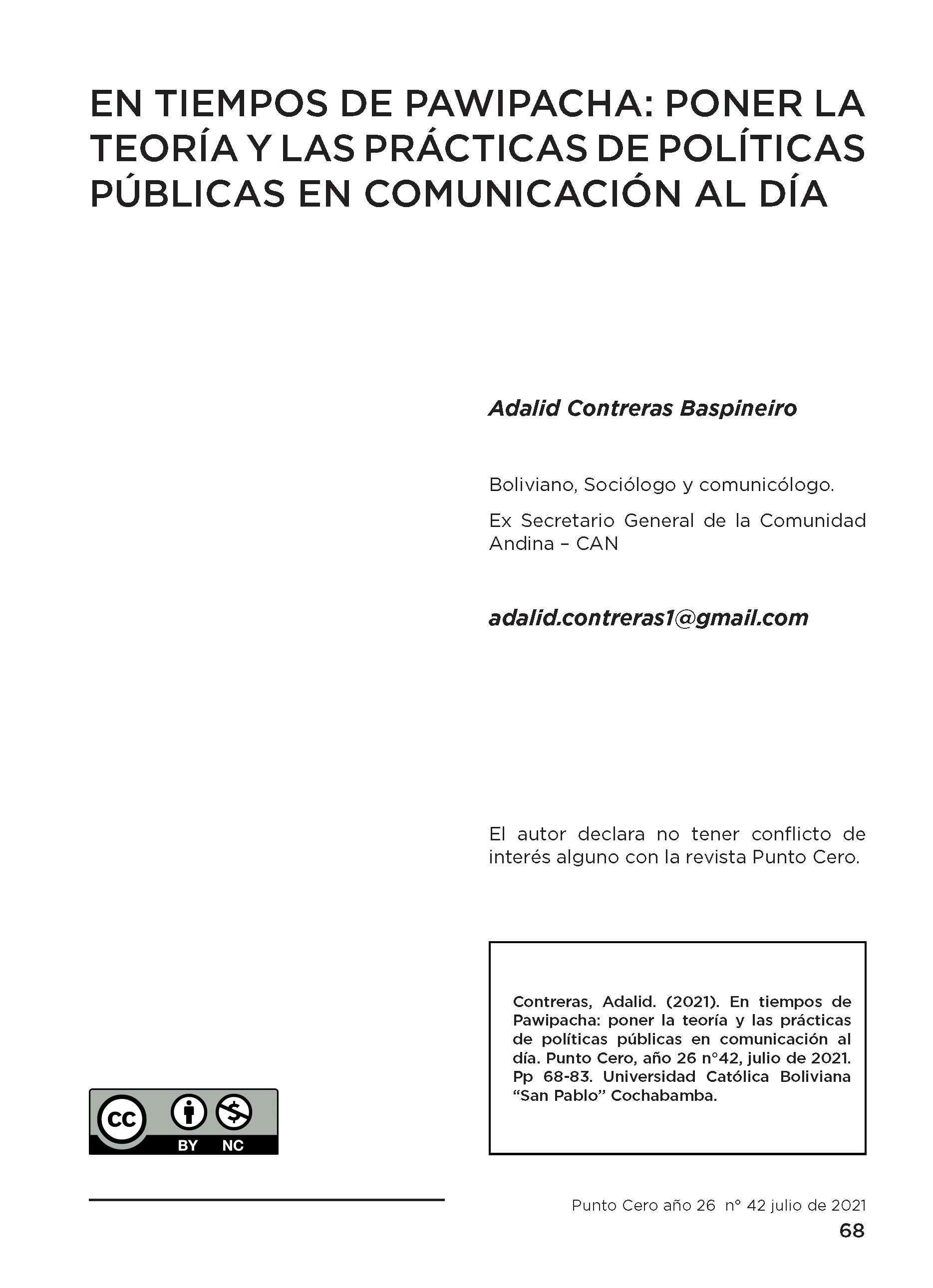In the times of Pawipacha: putting the theory and public policies practices in communication up to date
DOI:
https://doi.org/10.35319/puntocero.20214271Keywords:
Public Policies in Communication, Pawipacha, Right to Communication, Democratization of Communication and Society, Digital Social Networks, Political Communication, Interculturality, Public-Private Hybridization, FeelingsAbstract
The theory of communication has been enriched with the approach of public policies in communication, which condense an accumulation of achievements for the democratization of communication and society. The legislation has also opened paths of forms of participatory democracy with the exercise of the right to information and communication. Nevertheless, communication practices at the decision- making levels about these policies are not keeping pace with altruistic theory or humanist legislation. On the contrary, it has become instrumentalist, functional to the powers, uprooting itself from the citizenships. In this environment, immersed in a time of uncertainty (Pawipacha), we propose to update the theory and the practices of public policies in communication, critically considering the following factors: i) question (in) communication in its context and relations of power ; ii) question public policies in communication focused on media dynamics, opening it up to the nature of digital social networks; iii) question the western nature of public policies, in order to complement it with the vivifying emergence of intercultural paradigms; and iv) question the notion of the public from the hybrid forms of constitution of the public and the private in the decentralization of societies. Updating the theory, legislation and practices of public policies in communication, constitutes an opportunity to retake the flags of the democratization of communication and society.
References
CONTRERAS B., Adalid (2014). Sentipensamientos. De la comunicación- desarrollo a la comunicación para el vivir bien. UASB, Quito.
CONTRERAS B., Adalid (2017). Jiwasa. Comunicación participativa para la convivencia. FES, Quito.
CONTRERAS B., Adalid (2019). El buen-convivir y bien-transformar en la comunicación. Sistematización de prácticas innovadoras para el Buen Vivir. Signis América Latina, Quito.
CONTRERAS B., Adalid (2020). El discurso electoral, en su fondo y en su superficie, Columna de opinión “Todavía Soñamos”. ERBOL, La Paz.
CONTRERAS B., Adalid y CARRASCO, Diego (2006). Transiciones de la libertad de expresión al derecho a la comunicación. Azul Editorial. La Paz.
FERNÁNDEZ, Fátima (2002). La responsabilidad de los medios de comunicación. Paidos, México DF.
HAMELINK, Cees (2005). Derechos humanos para una sociedad de información, en Marques de MELO, José (organizador), Derechos a la comunicación en una sociedad de la información. Universidad Metodista de Sao Paulo.
MCBRIDE, Sean (1980). Un solo mundo, voces múltiples. Fondo de Cultura Económica, México.
MEDELLÍN T., Pedro (2000). Et al., Guía para la estructuración de políticas públicas de seguridad ciudadana. Consejería Presidencial para la Convivencia y Seguridad Ciudadana, Escuela Superior de Administración Pública, Federación Colombiana de Municipios y Fundación José Ortega y Gasset, Bogotá.
TORRICO, Erick (1992). Comunicación, política y emisión ideológica. Sindicato de Trabajadores de la Prensa de La Paz, Centro de Estudios de la Información y la Comunicación. La Paz.
VAN DIJCK, Teun (1998). Estructuras y funciones del discurso. Una introducción interdisciplinaria a la lingüística del texto y a los estudios del discurso. Siglo XXI, México. 5o edición.
VELÁSQUEZ, Jorge Alberto (2014). La comunicación: fundamento de las políticas públicas. Revista Comunicación N° 31. Medellín.
VERÓN, Eliseo (1997). La semiosis social: fragmentos de una teoría de la discursividad. Gedisa, Barcelona.
WALSH, Catherine (2009). Interculturalidad, Estado, sociedad. Luchas (deo)coloniales de nuestra época. UASB/Abya Yala, Quito.

Downloads
Published
How to Cite
Issue
Section
License
Copyright (c) 2021 Revista Punto Cero

This work is licensed under a Creative Commons Attribution-NonCommercial 4.0 International License.








